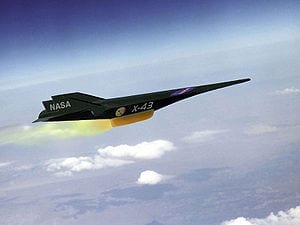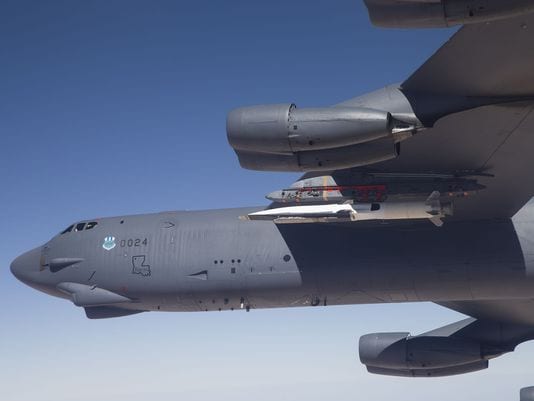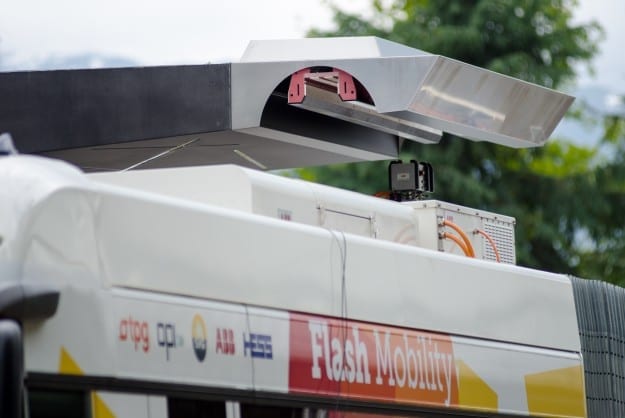
Hypersonic weapons: Building vehicles that fly at five times the speed of sound is amazingly hard, but researchers are trying
ON AUGUST 20th 1998 Bill Clinton ordered American warships in the Arabian Sea to fire a volley of more than 60 Tomahawk cruise missiles at suspected terrorist training camps near the town of Khost in eastern Afghanistan. The missiles, flying north at about 880kph (550mph), took two hours to reach their target. Several people were killed, but the main target of the attack, Osama bin Laden, left the area shortly before the missiles struck. American spies located the al-Qaeda leader on two other occasions as he moved around Afghanistan in September 2000. But the United States had no weapons able to reach him fast enough.
After the terrorist attacks of September 11th 2001, American officials decided that they needed to obtain a “prompt global strike” capability, able to deliver conventional explosives anywhere on Earth within an hour or two. One way to do this would be to take existing intercontinental ballistic missiles (ICBMs) and replace the nuclear warheads with standard explosives. The hitch is that ballistic missiles are usually armed with nuclear warheads. A launch could therefore be misconstrued as the start of a nuclear strike, says Arun Prakash, a former Chief of the Naval Staff, the top job in India’s navy.
Moreover, ICBMs carrying conventional explosives towards targets in Asia or the Middle East would at first be indistinguishable from those aimed at China or Russia, according to a paper issued by the Congressional Research Service, an American government-research body. This uncertainty might provoke a full-scale nuclear counterattack. In the years after 2001 funding for non-nuclear ballistic missiles was repeatedly cut by Congress, until military planners eventually gave up on the idea. Instead, they have now pinned their hopes on an alternative approach: superfast or “hypersonic” unmanned vehicles that can strike quickly by flying through the atmosphere, and cannot be mistaken for a nuclear missile.
These hypersonic vehicles are not rockets, as ICBMs are, but work in a fundamentally different way. Rockets carry their own fuel, which includes the oxygen needed for combustion in airless space. This fuel is heavy, making rockets practical only for short, vertical flights into space. So engineers are trying to develop lightweight, “air breathing” hypersonic vehicles that can travel at rocket-like speeds while taking oxygen from the atmosphere, as a jet engine does, rather than having to carry it in the form of fuel oxidants.
The term hypersonic technically refers to speeds faster than five times the speed of sound, or Mach 5, equivalent to around 6,200kph at sea level and 5,300kph at high altitudes (where the colder, thinner air means the speed of sound is lower). Being able to sustain flight in the atmosphere at such speeds would have many benefits. Hypersonic vehicles would not be subject to existing treaties on ballistic-missile arsenals, for one thing. It is easier to manoeuvre in air than it is in space, making it more feasible to dodge interceptors or change trajectory if a target moves. And by cutting the cost of flying into the upper reaches of the atmosphere, the technology could also help reduce the expense of military and civilian access to space.
All this, however, requires a totally different design from the turbofan and turbojet engines that power airliners and fighter jets, few of which can operate beyond speeds of about Mach 2. At higher speeds the jet engines’ assemblies of spinning blades can no longer slow incoming air to the subsonic velocities needed for combustion. Faster propulsion relies instead on engines without moving parts. One type, called a ramjet, slows incoming air to subsonic speeds using a carefully shaped inlet to compress and thereby slow the airstream. Ramjets power France’s new, nuclear-tipped ASMPA missiles. Carried by Rafale and Mirage fighter jets, they are thought to be able to fly for about 500km at Mach 3, or around 3,700kph.
It’s not rocket science
But reaching hypersonic speeds of Mach 5 and above with an air-breathing engine means getting combustion to happen in a stream of supersonic air. Engines that do this are called supersonic-combustion ramjets, or scramjets. They also use a specially shaped inlet to slow the flow of incoming air, but it does not slow down enough to become subsonic. This leaves engineers with a big problem: injecting and igniting fuel in a supersonic airstream is like “lighting a match in a hurricane and keeping it lit,” says Russell Cummings, a hypersonic-propulsion expert at California Polytechnic State University.
The Latest Bing News on:
Hypersonic missiles
- UK to develop hypersonic missiles to catch up with China and Russia by 2030 - reporton April 27, 2024 at 5:54 pm
Plans are at an early stage, according to a newspaper report, although there is no decision on whether the missile will be launched from land, sea or air.
- Britain's aims to get its own hypersonic missile into service by 2030on April 27, 2024 at 3:44 pm
Britain plans to deploy a UK-made hypersonic cruise missile by 2030, that could smash into Moscow in just 24 minutes. Military chiefs want to catch up with China, Russia and the United States by ...
- UK-made hypersonic missile ‘could enter service by 2030’on April 27, 2024 at 1:55 pm
Britain plans to deploy a UK-made hypersonic cruise missile by 2030, it has been reported. Military chiefs want to catch up with China, Russia and the United States by developing a weapon capable of ...
- Britain to deploy homegrown hypersonic missile by 2030on April 27, 2024 at 12:17 pm
Britain plans to equip the Armed Forces with a homegrown hypersonic cruise missile by the end of the decade, The Telegraph has learnt.
- Ukrainian Air Force struggling to counter Russian Kinzhal missiles due to lack of Patriot systemson April 27, 2024 at 7:00 am
Russia struck with Kinzhal missiles, which are difficult to intercept, during a massive overnight attack, Illya Yevlash, a spokesperson for the Air Force of Ukraine, said on national television on ...
- Drones and Missiles Mean Navy Aircraft Carriers are in Deep Troubleon April 26, 2024 at 5:23 am
The U.S. Navy's aircraft carriers, long the dominant force in maritime strategy, face increasing threats from advanced weapons systems like hypersonic missiles, anti-access/area denial (A2/AD) ...
- Lockheed Martin’s ‘Mako,’ the U.S. Navy’s Powerful New Multi-Mission Hypersonic Missile, is Officially Unveiledon April 25, 2024 at 5:27 am
Lockheed Martin’s new Mako missile, the first hypersonic weapon compatible with fifth-generation fighter aircraft, has made its debut.
- Lawmakers put up $26 million to fund 'bleeding edge' hypersonic research at Embry-Riddleon April 24, 2024 at 5:21 am
Embry-Riddle Aeronautical University, in partnership with UCF, has landed a $26 million state appropriation for a hypersonic research facility.
- The Blistering New Hypersonic Missile That Will Give the F-35 Fangson April 19, 2024 at 8:00 am
A combination of stealth and hypersonic speed leaves an enemy with very little time to react.
- Russian Hypersonic Missile Scientist Jailed for 'High Treason'on April 18, 2024 at 3:36 pm
Alexander Kuranov has been sentenced to seven years in a "high-security penal colony," a Russian newspaper reported.
The Latest Google Headlines on:
Hypersonic missiles
[google_news title=”” keyword=”Hypersonic missiles” num_posts=”10″ blurb_length=”0″ show_thumb=”left”]
The Latest Bing News on:
Hypersonic weapons
- UK to develop hypersonic missiles to catch up with China and Russia by 2030 - reporton April 27, 2024 at 5:54 pm
Plans are at an early stage, according to a newspaper report, although there is no decision on whether the missile will be launched from land, sea or air.
- Britain's aims to get its own hypersonic missile into service by 2030on April 27, 2024 at 3:44 pm
Britain plans to deploy a UK-made hypersonic cruise missile by 2030, that could smash into Moscow in just 24 minutes. Military chiefs want to catch up with China, Russia and the United States by ...
- UK-made hypersonic missile ‘could enter service by 2030’on April 27, 2024 at 1:55 pm
Britain plans to deploy a UK-made hypersonic cruise missile by 2030, it has been reported. Military chiefs want to catch up with China, Russia and the United States by developing a weapon capable of ...
- Britain to deploy homegrown hypersonic missile by 2030on April 27, 2024 at 12:17 pm
Britain plans to equip the Armed Forces with a homegrown hypersonic cruise missile by the end of the decade, The Telegraph has learnt.
- Lawmakers put up $26 million to fund 'bleeding edge' hypersonic research at Embry-Riddleon April 24, 2024 at 5:21 am
Embry-Riddle Aeronautical University, in partnership with UCF, has landed a $26 million state appropriation for a hypersonic research facility.
- Zumwalt-Class Stealth Destroyer: Hypersonic Missile Truck or Giant Failure?on April 23, 2024 at 4:54 am
Zumwalt will be pushing ten years old once its hypersonic weapons are installed, assuming its current yard period wraps up on schedule. That’s a sizable share of its service life.
- The Blistering New Hypersonic Missile That Will Give the F-35 Fangson April 19, 2024 at 8:00 am
A combination of stealth and hypersonic speed leaves an enemy with very little time to react.
- Russian Hypersonic Missile Scientist Jailed for 'High Treason'on April 18, 2024 at 3:36 pm
Alexander Kuranov has been sentenced to seven years in a "high-security penal colony," a Russian newspaper reported.
- Scientists are now using cheap NVIDIA chips to control hypersonic weaponson April 18, 2024 at 1:23 am
Researchers announced they can control a hypersonic weapon using a low-cost NVIDIA Jetson module, which they say is a perfect fit.
- Tech war: how Chinese scientists rigged a low-cost AI computer chip to power a hypersonic weaponon April 16, 2024 at 10:03 am
Using a Nvidia module widely available online, Chinese researchers overcome significant obstacles to boost the performance of a hypersonic vehicle.
The Latest Google Headlines on:
Hypersonic weapons
[google_news title=”” keyword=”Hypersonic weapons” num_posts=”10″ blurb_length=”0″ show_thumb=”left”]










